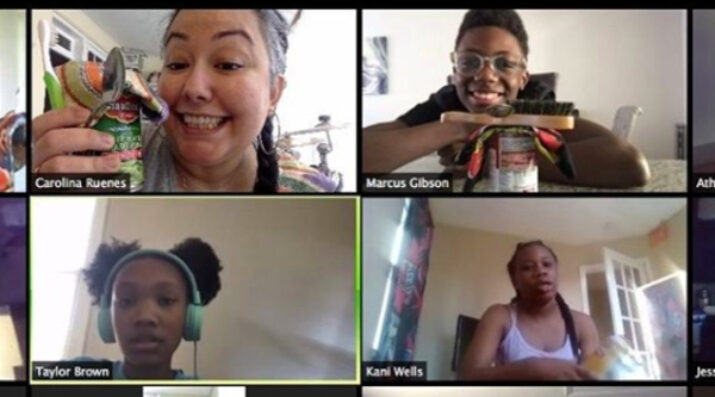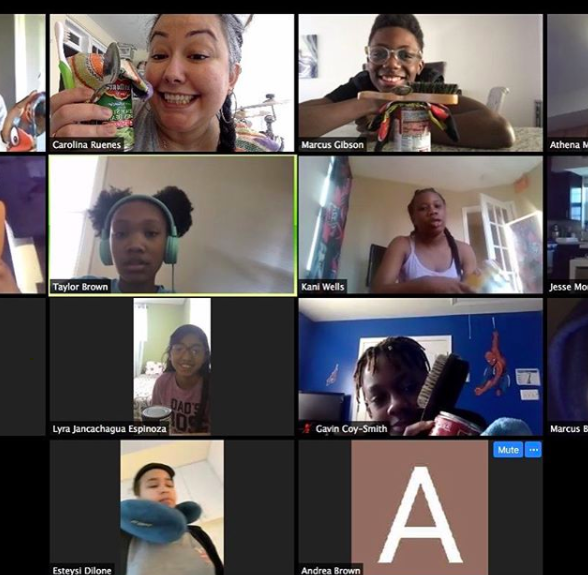Connection, Core Content, and Creativity: Three Values for Distance Learning
Topics

We’ve all had the experience of truly purposeful, authentic learning and know how valuable it is. Educators are taking the best of what we know about learning, student support, effective instruction, and interpersonal skill-building to completely reimagine schools so that students experience that kind of purposeful learning all day, every day.
With school building closures during the coronavirus pandemic, Two Rivers in Washington, D.C. is guided by 3 core values: connection, core content, and creativity.
Last month, as Two Rivers Public Charter School embarked on the distance learning experiment thrust on us by the novel coronavirus pandemic, we scrambled to move our school community in the heart of Washington, D.C. online. Prior to school closing, Two Rivers thrived as a community of learners that values close relationships, collaborative learning, and deep cognitive engagement. All of these values we realized would be put to the test in the new context of social distancing where we can’t actually be in a shared space with our students.
In the second week of our shutdown and the urgent effort to provide some stability and continuity to our students’ learning experiences, our instructional leadership team paused. We paused to reflect on what we hoped for in terms of learning in these very uncertain times. The team identified three core values that would guide our work as we designed for distance learning: connection, core content, and creativity. As we grapple with defining what learning can look like for our students, these three values will be our guiding light.
We realize that we are living the design thinking process while simultaneously trying to run a school. We will need to experiment, try things out, fail, and redesign. In addition, our context is constantly changing without a clear sense of how long our students will be out of school, the very pressing need to get food for some of our students experiencing food insecurity, and the very real challenges of providing a quality education to students whose families have varying ability to connect online and time to spend one-on-one with their children.
We come to this work with a great deal of humility and realize that we haven’t even begun to find the answers to all of the challenges that we are facing. However, we have begun to design and innovate around our three core values. In our best moments we are seeing the light through the clouds.
Connection
We started with connection. We realized that the heart of our school is the learning community created by shared connection. We realized it would be possible to deliver instruction virtually as a technical fix. However, deep lasting learning could only be fostered through connections. We needed our connections now more than ever.
As an EL Education school, we root our connections in the concept of crew. On their website, EL Education writes that “Crew is two things:
- It is a structure. A group of students who meet together to support each other and push each other in school, and life.
- It is a spirit, a way of being. To be 'Crew' means to pitch in to help each other, to step up and take responsibility for everyone's well being around you.” (EL Education 2020).
As we moved our school online, our first question was this: How do we continue both the structure and spirit of crew? The answer quickly coalesced around a couple of practices. We hold regular student and staff crew meetings over Zoom and whole school community meetings using Flipgrid.

A virtual crew meeting on Zoom with 6th graders from Two Rivers Public Charter School. (Courtesy of Two Rivers Public Charter School)
First, we created regular opportunities for students to connect in their classroom crews with their teachers. We use the Responsive Classroom practices of morning meetings to structure our crew meetings with greetings, shares, initiatives and news and announcements. Several times a week students can come together to be seen and have a little fun. This keeps our community connected and continues a familiar routine that is an essential part of school life. Similarly, we run our virtual staff meetings as adult crew time. In those meetings, while we address the important business of answering essential questions, we also have fun and remember to laugh together.

Screenshot of Flipgrid Community Meeting from Two Rivers Public Charter School, 2020. (Courtesy of Two Rivers Public Charter School)
In addition to crew meetings, we also found a way to continue our weekly community meetings. These have shifted from live gathers to a Flipgrid interaction where students are able to take part in each of the components of our regular community meetings. Students can post videos with their families participating in a greeting, initiative, Spanish phrase of the week, the Mathemagical Wizardry Prize, and other activities.
Core Content
I’ll be brief on this topic because much has been written elsewhere about teaching core content through distance learning. (For example, see Approaches to Instruction during School Closure by Julie Kennedy and Charter School Growth Fund; it is comprehensive and addresses all that I would have wanted to share on this topic.) Teaching core content was an essential aspect of our work to move our school online, and we are following many other schools’ powerful leads. Google Classroom is our primary learning management system. In addition, we use a combination of Zoom meetings, Flipgrid, YouTube videos, and teacher-created Weebly webpages, among other tools, to provide live learning opportunities multiple times a week as well as asynchronous lessons.
Creativity
Finally, we found that the current challenge provided us with an opportunity. In addition to connection and continuing core content, we felt that we needed to leverage the opportunity to promote creativity and curiosity. One of our 5th grade teachers, Kathryn Mancino, has been leading the way with her implementation of Genius Hour, the concept of turning 20 percent of school time over to self-directed student projects.
A week after school buildings closed, Mancino quizzed her students about what topics they would be interested in studying in depth. Topics ranged from Legos to the solar system and from African art to animal immune systems. She then created a structure for students to learn about their topics with support from advisors. Utilizing this form, she created a structure for students to work on projects of their choosing with regular accountability. Mancino recruited advisors from across our school community. The advisors’ job is to check in weekly with students and guide them around resources, questions that might be worth pursuing, and product generation. Through Genius Hour, students are able to follow their own particular passions to learn and drive toward an authentic way for them to share their learning with others. Because Genius Hour is open-ended, students are free to be creative and curious.
Three Values for Distance Learning
We are in uncharted waters with our distance learning experiment. We certainly have lots to learn and we are surely going to fail over and over again as we try to make this work. However, by rooting ourselves in the three core values of connection, core content, and creativity, we have provided ourselves with a north star. We know what we want to be true for all of our students. We want them to be connected, to continue to learn core content, and to have opportunities to foster their creativity. As we stumble toward ways to realize these values, we are rooted in not what but how we make this true.




